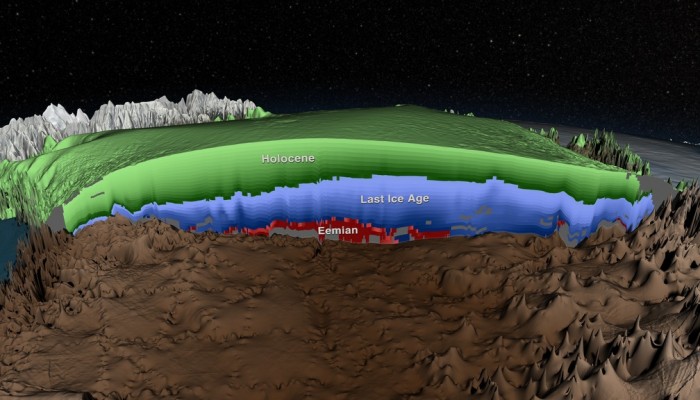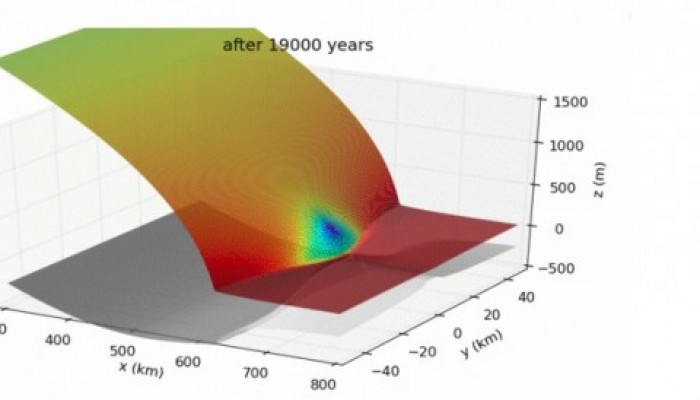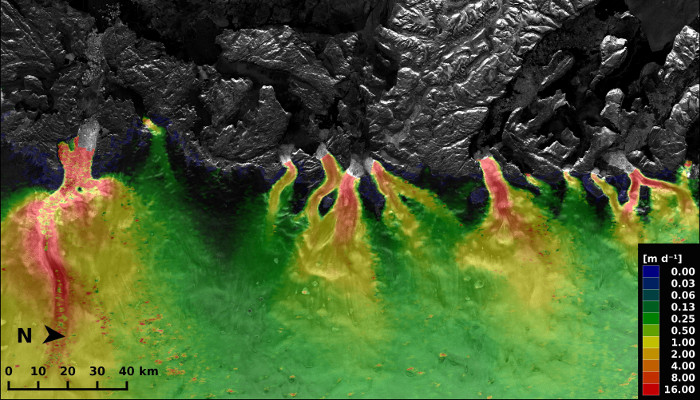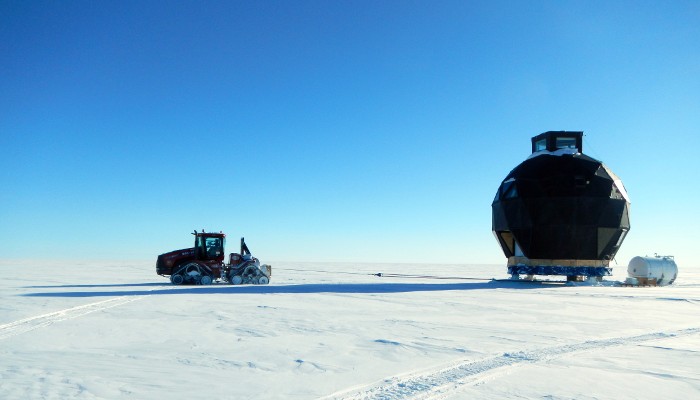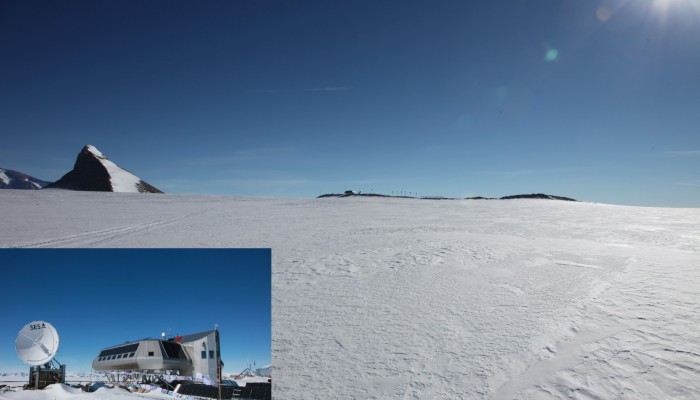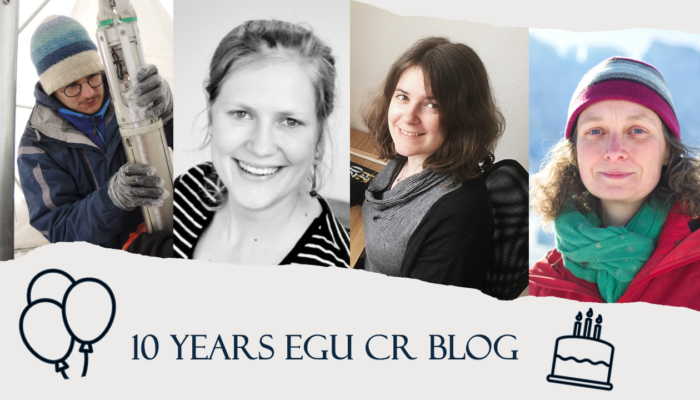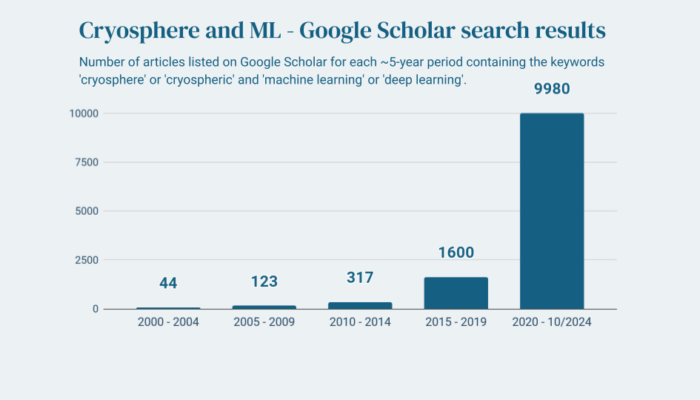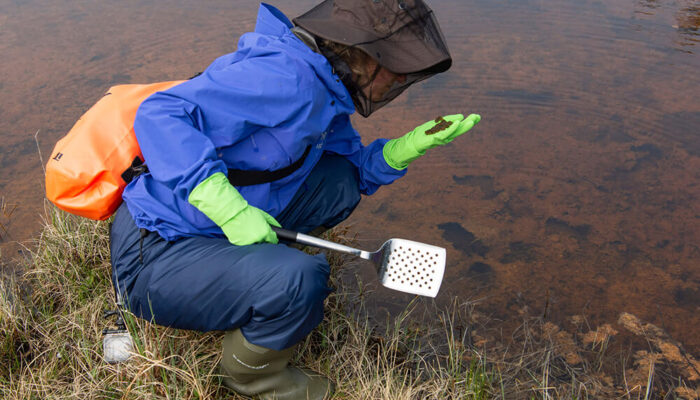The image shows a cross section of the Greenland Ice Sheet, where a recent study by MacGregor et al. have mapped the layers imaged by radar. Thanks to ice core measurements the age of the layers have been determined, and in the image the layers from the Holocene period (the past 11.700 years) are shown in green. The ice formed during the last ice age, that spanned 11.700 to 115.000 years ago are c ...[Read More]
If you didn't find what you was looking for try searching again.
Cryospheric Sciences
Image of the week : formation of an ice rise
Deglaciation and formation of an ice rise with the ice-sheet model BISICLES. The simulation starts with an ice sheet in steady state that overrides a topographic high in the bed, close to the calving front. The sea level is then forced to rise steadily with 1 cm per year during 15 thousand years, and the simulation goes on until the ice sheet reaches steady state. The animation below shows that t ...[Read More]
Cryospheric Sciences
Image of the Week: Greenland Ice Streams
This image is from the west coast of Greenland and it shows several glaciers flowing towards the sea (upper part of the image), transporting ice into the ocean. The colours show the velocity of the ice. As the ice gets nearer to the coast it speeds up reaching speeds over 15m/day. The velocities were calculated using two Sentinel-1A radar scans from 3 and 15 January 2015. You can download a high r ...[Read More]
Cryospheric Sciences
Science and Shovels: Traversing across the Greenland Ice Sheet.
Moving 150 tonnes of equipment more than 450km across the Greenland Ice Sheet sounds like a crazy idea. In that context, moving a 14-metre high, dome-shaped, wooden structure seems like a minor point, but it really is not. I do not think I realised what an awesome and awe-inspiring project I was part of, until I was out there, in the middle of the blindingly white ice sheet, and I saw the enormous ...[Read More]
Cryospheric Sciences
Ice Nomads: The iSTAR traverse of Pine Island Glacier, West Antarctica
It’s the 2nd December 2013 and I find myself in one of those rare occasions in life where I feel I need to pinch myself to see if I’m dreaming. Why? Somehow I’m in control of a British Antarctic Survey De Havilland Twin Otter aircraft flying over the white featureless expanse of the West Antarctic Ice Sheet. I’m part of a team of 12 heading to Pine Island Glacier, a remote ice stream 75°S and arou ...[Read More]
Cryospheric Sciences
My first journey to Antarctica – Brice Van Liefferinge
19 November 2014, the Iliuchine 76 gently lands on the runway of the Russian Antarctic station, Novolazarevskaya, in Dronning Maud Land. For the first time, I’m in Antarctica! It is 4 o’clock in the morning and we need to hurriedly offload 2 tons of material intended for our field mission near the Belgian Princess Elisabeth Station. I’m deeply impressed by the landscape although it is dotted with ...[Read More]
Cryospheric Sciences
Happy birthday to the Cryoblog!
The EGU Cryosphere Blog is now 10 years old: Happy Birthday! It all started in December 2014 with this blog post from Nanna Karlsson, and now counts 452 blog posts across 25 blog categories, including winning three Best EGU blog posts (2016, 2019 and 2021). 881 different (hash)tags were used in our blog posts, with way more counts on Antarctica and climate than the Arctic. Since the start, ...[Read More]
Cryospheric Sciences
Did you know? Machine learning can help us understand the cryosphere!
Recently, Machine Learning (ML) has emerged as a powerful tool within cryospheric sciences, offering innovative and effective solutions for observing, modelling and understanding the frozen regions of the Earth. From learning snowfall patterns and predicting avalanche dynamics to speeding up the process of modelling ice sheets, ML has transformed cryospheric sciences and bears many o ...[Read More]
Cryospheric Sciences
Dreaming & reading about fieldwork – summer blog break 2024
As we are starting into our annual blog summer break, we reflect on what summer can mean for polar researchers (including some fieldwork saudades). As an Arctic or Alpine cryo-scientist, chances are that you are somewhere in between vacation, fieldwork or trying to work through data while everyone else is free. If you, like us, did not have your vacation yet or do not have any fieldwork com ...[Read More]
Cryospheric Sciences
Women of Cryo VII: Making Fieldwork More Inclusive
Women make up 50.8% of the world’s population, yet fewer than 30% of the world’s researchers are women. Of this percentage, women of colour comprise around 5%, with less than 1% represented in geoscience faculty positions. Women are published less, paid less, and do not progress as far in their careers as men. Even within our EGU community, women account for only one third of all members, and make ...[Read More]

